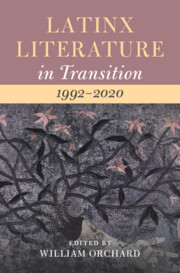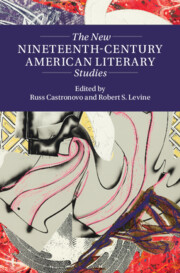Refine search
Actions for selected content:
78 results
14 - Indigenous Peoples and Electoral Politics in Thailand and Cambodia
- from Part III - Africa and Asia
-
-
- Book:
- Land Rights Now
- Print publication:
- 25 September 2025, pp 310-330
-
- Chapter
-
- You have access
- Open access
- HTML
- Export citation
Legislator Responsiveness to Racialized Constituencies in Mexico
-
- Journal:
- Journal of Experimental Political Science , First View
- Published online by Cambridge University Press:
- 23 July 2025, pp. 1-13
-
- Article
-
- You have access
- Open access
- HTML
- Export citation
17 - Aversive and Antagonistic Personality Disorder
- from Part IV - Exploring Negative Consequences of Diagnosing Personality Disorder
-
-
- Book:
- Conceptualizing Personality Disorder
- Published online:
- 25 June 2025
- Print publication:
- 10 July 2025, pp 297-314
-
- Chapter
- Export citation

Latinx Literature in Transition, 1992–2020
-
- Published online:
- 19 June 2025
- Print publication:
- 03 July 2025
Chapter 7 - Plantation
- from Part II - Developments
-
-
- Book:
- Space and Literary Studies
- Published online:
- 07 May 2025
- Print publication:
- 22 May 2025, pp 120-139
-
- Chapter
- Export citation
Chapter 5 - Brown Modernism from María Cristina Mena to Gloria Anzaldúa
- from Part II - Being
-
-
- Book:
- Latinx Literature in Transition, 1848–1992
- Published online:
- 10 April 2025
- Print publication:
- 17 April 2025, pp 95-110
-
- Chapter
- Export citation
Chapter 10 - Passing Time
- from Part III - Time
-
-
- Book:
- Latinx Literature in Transition, 1848–1992
- Published online:
- 10 April 2025
- Print publication:
- 17 April 2025, pp 178-194
-
- Chapter
- Export citation
Chapter 15 - Beyond the City and the Country: Rural Scarcity and Indigenous Survivance
- from Part II - Issues
-
-
- Book:
- The Cambridge Companion to Nineteenth-Century American Literature and Politics
- Published online:
- 06 March 2025
- Print publication:
- 13 March 2025, pp 253-268
-
- Chapter
- Export citation
Chapter 12 - Territoriality: The Possessive Logics of American Placemaking
- from Part II - Issues
-
-
- Book:
- The Cambridge Companion to Nineteenth-Century American Literature and Politics
- Published online:
- 06 March 2025
- Print publication:
- 13 March 2025, pp 205-220
-
- Chapter
- Export citation
Chapter 13 - A ‘sweet especial rural scene’? Nature, Culture, and Agriculture in the 1870s
-
-
- Book:
- Nineteenth-Century Literature in Transition: The 1870s
- Published online:
- 30 January 2025
- Print publication:
- 06 February 2025, pp 274-294
-
- Chapter
- Export citation
Chapter 20 - “Unfeeling Stone”
-
-
- Book:
- The New Nineteenth-Century American Literary Studies
- Published online:
- 02 January 2025
- Print publication:
- 23 January 2025, pp 297-308
-
- Chapter
- Export citation
Common Ways to See Differently: Race, Mestizaje, and Criollismo as Seen by Blind People in Chile and Venezuela
-
- Journal:
- Latin American Research Review ,
- Published online by Cambridge University Press:
- 16 January 2025, pp. 1-18
-
- Article
-
- You have access
- Open access
- HTML
- Export citation

The New Nineteenth-Century American Literary Studies
-
- Published online:
- 02 January 2025
- Print publication:
- 23 January 2025
2023 ASR Distinguished Lecture: Decoloniality and Its Fissures. Whose Decolonial Turn?
-
- Journal:
- African Studies Review / Volume 67 / Issue 4 / December 2024
- Published online by Cambridge University Press:
- 19 December 2024, pp. 817-836
-
- Article
- Export citation
Missionary Internalizations of Ghanaian Christianity - Healing and Power in Ghana: Early Indigenous Expressions of Christianity Paul Glen Grant. Waco: Baylor University Press, 2020. Pp. 327. $67.99, hardcover (ISBN: 9781481312677).
-
- Journal:
- The Journal of African History / Volume 65 / Issue 2 / July 2024
- Published online by Cambridge University Press:
- 20 November 2024, pp. 272-274
-
- Article
- Export citation
7 - The Imperial Logic of American Bioethics
- from Part II - Institutional Encounters, Discipline, and Settler Colonial Logics
-
-
- Book:
- Empire, Colonialism, and the Human Sciences
- Published online:
- 24 October 2024
- Print publication:
- 07 November 2024, pp 176-208
-
- Chapter
-
- You have access
- Open access
- HTML
- Export citation
Preface
-
- Book:
- Empire, Colonialism, and the Human Sciences
- Published online:
- 24 October 2024
- Print publication:
- 07 November 2024, pp ix-xiv
-
- Chapter
-
- You have access
- Open access
- HTML
- Export citation
Chapter 9 - Beyond Humanization
- from Part III - The Dynamics of Race and Literary Dynamics
-
-
- Book:
- The Cambridge Companion to Race and American Literature
- Published online:
- 02 November 2024
- Print publication:
- 27 June 2024, pp 134-147
-
- Chapter
- Export citation
Conclusion
-
- Book:
- States-in-Waiting
- Published online:
- 09 May 2024
- Print publication:
- 16 May 2024, pp 230-240
-
- Chapter
-
- You have access
- Open access
- HTML
- Export citation
8 - Precarious Work in the Gig Economy
-
-
- Book:
- Diversity and Precarious Work During Socio-Economic Upheaval
- Published online:
- 01 February 2024
- Print publication:
- 08 February 2024, pp 137-162
-
- Chapter
- Export citation
